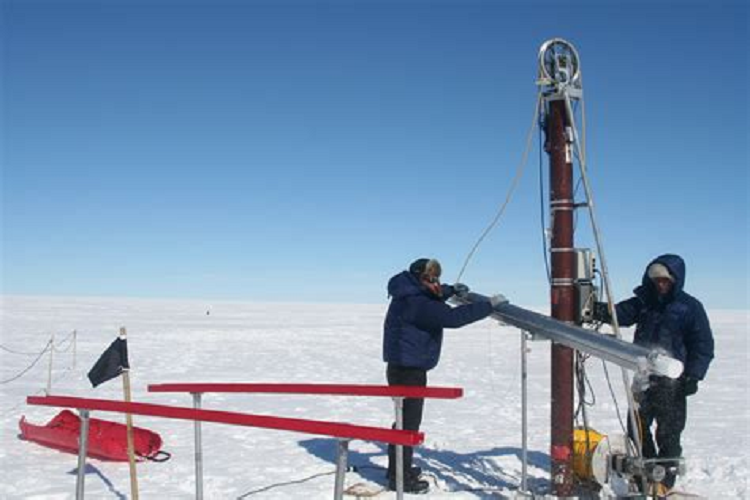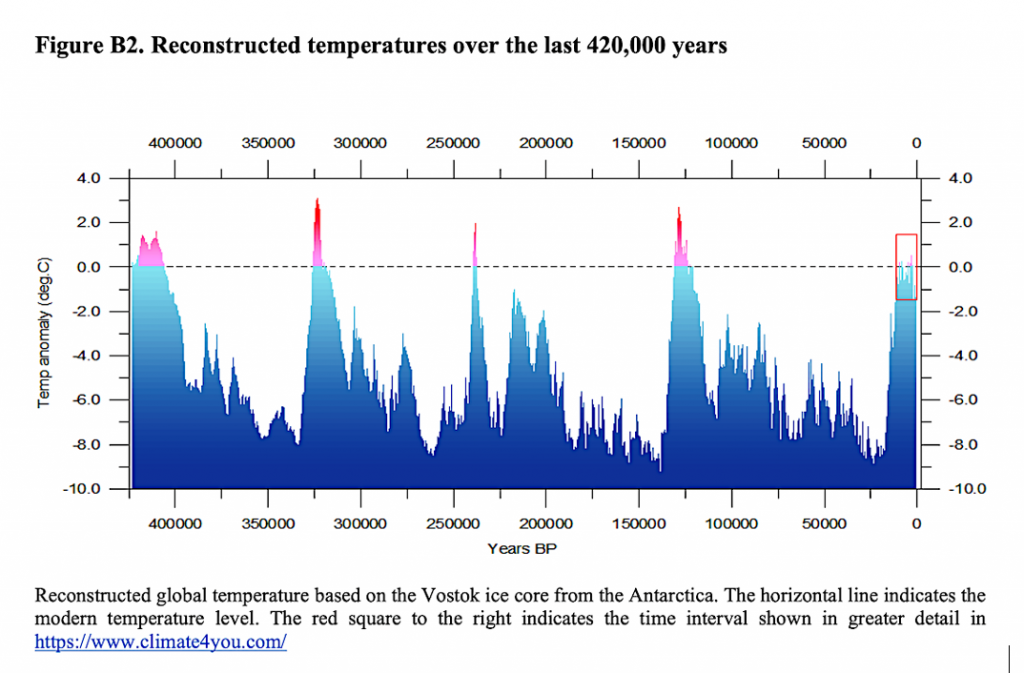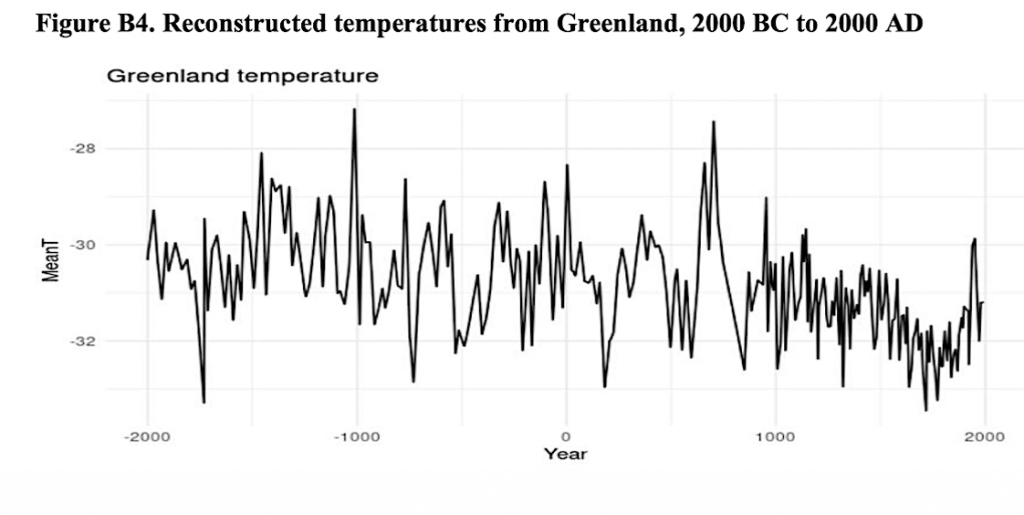ANOTHER NAIL IN THE GLOBAL WARMING COFFIN
Statistics Norway, the government agency that produces official statistics for that country, released a report last month titled “To What Extent Are Temperature Levels Changing Due To Greenhouse Gas Emissions?” The report concludes:
“[T]he results imply that the effect of man-made CO2 emissions does not appear to be sufficiently strong to cause systematic changes in the pattern of the temperature fluctuations. In other words, our analysis indicates that with the current level of knowledge, it seems impossible to determine how much of the temperature increase is due to emissions of CO2.”
The report looks at the last 400,000+ years of Earth’s climate history:
“The preceding four interglacial periods are seen at about 125,000, 280,000, 325,000 and 415,000 years before now, with much longer glacial periods in between. All four previous interglacial periods are seen to be warmer than the present. The typical length of a glacial period is about 100,000 years, while an interglacial period typically lasts for about 10-15,000 years. The present inter-glacial period has now lasted about 11,600 years.”
So sometime relatively soon, the Earth is going to start getting really, really cold. This accompanying chart shows that history, based on ice cores:
Similarly, on the time scale of recent millennia, current temperatures are nothing unusual:
“Kobashi et al. (2011) have reconstructed Greenland surface snow temperature variability over the past 4,000 years (until 1993) at the GISP2 site (near the Summit of the Greenland ice sheet) with a new method that utilizes argon and nitrogen isotopic ratios from occluded air bubbles (Figure B4, Appendix B). These data indicate that warmer temperatures were the norm in the earlier part of the past 4,000 years, including century-long intervals nearly 1°C warmer than the decade (2001-2010).
Therefore, it appears that the current decadal mean temperature in Greenland has not exceeded the envelope of natural variability over the past 4,000 years. Schönwiese (1995) has reconstructed temperatures from ice cores in Greenland for the last 11,000 years (Figure B5, Appendix B). These reconstructions show that during the past 10,000 years temperatures over long periods were higher than they are today. The warmest phase occurred 4,000 to 8,000 years ago and is known as the Holocene Climate Optimum or the Atlantic Period.”
This chart, included in the report, shows the last 4,000 years, based on Greenland ice cores:
There is much more in the report, although it is not very long. It criticizes the models on which climate alarmism is based; there is nothing alarming in the observational record:
“In the global climate models (GCMs) most of the warming that has taken place since 1950 is attributed to human activity. Historically, however, there have been large climatic variations. Temperature reconstructions indicate that there is a ‘warming’ trend that seems to have been going on for as long as approximately 400 years.
Prior to the last 250 years or so, such a trend could only be due to natural causes. The length of the observed time series is consequently of crucial importance for analyzing empirically the pattern of temperature fluctuations and to have any hope of distinguishing natural variations in temperatures from man-made ones.”
This is another interesting point about the models:
“[Global climate models] are typically evaluated applying the same observations used to calibrate the model parameters. In an article in Science, Voosen (2016) writes; ‘Indeed, whether climate scientists like to admit it or not, nearly every model has been calibrated precisely to the 20th century climate records – otherwise it would have ended up in the trash.’
Unfortunately, models that match 20th century data as a result of calibration using the same 20th century data are of dubious quality for determining the causes of the 20th century temperature variability. The problem is that some of the variables representing sources of climate variability other than greenhouse gases are not properly controlled for during the calibrations. The resulting calibration of the climate sensitivity may therefore be biased. Further critical evaluations are given by several authors, such as Essex (2022).
Most of this is not new. The fact that the Earth’s climate has changed many times over the millennia for reasons that are not understood, and that the Earth’s climate history is replete with periods that were warmer than what we are experiencing now, has long been known.
What is noteworthy, I think, is that a government agency is willing to say out loud what skeptics have been saying for years.
The Norwegians’ defection is important because climate alarmism can survive only if it is deemed an official “consensus,” so that people who point out inconsistent facts can be censored. Once the purported consensus is punctured, it rapidly becomes clear that the Climate Emperor is unclothed.
Western governments (not, of course, China, India or the third world) have rushed to embrace the “consensus” because the supposed climate crisis is an endless excuse for extending government power over everything, from the largest power plant to your gas stove. And governments like power.
But the Europeans, in particular, are having second thoughts. The de-industrialization of Germany has been shocking, and millions of Europeans are wondering how, exactly, that continent will retain its prosperity when energy is so expensive that nothing can be manufactured there, and everything that Europeans do is vastly more costly than at present, with zero incremental production to balance the increased costs, and frequent non-existence, of inefficient energy.
Which is why I think last month’s Norwegian report is one more nail in the coffin of climate hysteria.
John Hinderaker is the editor of PowerLine.




